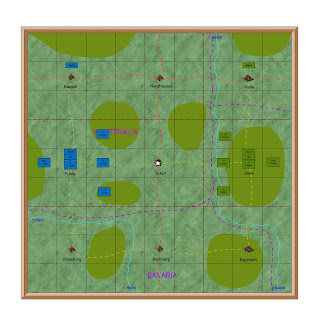Town of Weissensee
The
first day of our new campaign involved a battle for the town of
Weissensee. It highlighted the
difficulty of having simple rules for fighting in BUA.
On
our wargame table BUA are represented by 6x6” squares of felt. Suitable wargame houses are placed on them to
represent villages (1 square), towns (2 squares) and cities (4 squares). These buildings are removed to allow us to
measure distance when troops enter them.
Our latest game involved a town, which is two squares. Each square requires one infantry brigade to garrison it. All casualties, morale and combat are calculated on one square. So a city requires four combats, one for each section.
Move 4
The
French commander has detached two infantry brigades to attack the nearest
section of the town. The leading
brigade has just entered the town, and a couple of buildings have been removed
to ease measurement. Only infantry can
enter a BUA, and they move at 4” per move, which is half of column speed.
A
second brigade is moving up in support.
Only one brigade can fight in a BUA, and one of our big problems is
trying to write simple rules to cover supports.
Towns
can only be attacked by artillery and infantry.
Artillery roll 2D6 and require 10 at long range or 6 at short
range. Minus 1 for each casualty and if
the guns fired last time. So you can
spend a lot of time firing at a town and doing no damage at all, especially at
long range.
Infantry
can skirmish a town, roll 1 D6 and need 6. Get plus 2 for B class
skirmishers. Minus 1 for each casualty
and also for target in hard cover. So
again it can take a long time to inflict any casualties.
Infantry
can storm a town. The garrison get plus
2. If two brigades attack together the get
plus 1. The garrison usually wins
unless they have casualties or are poor quality troops. Elite troops in garrison are a real
challenge.
But
the latest problem is for fighting inside the town
Move 8
Previously
we only allowed one brigade inside each town section. Supports had to wait outside. However it takes two moves to get from one edge of the square to the other.
In
our first attempt at Weissensee we followed that rule. Both sides moved to the far edge of their
town and the French charged the Russian brigade. The first combat was a draw, both lost 10%
casualties. The second, third and
fourth was the same. In a draw both
brigades are disordered, but carry on the melee. When they reached 40% both brigades were
automatically routed. So after four
moves of fighting both ran away! By
the time the reserve brigade came into contact it would be at least move 10, too late to resolve the combat.
We
then tried it with the reserve brigade allowed inside the town section, but not
allowed to fight unless they moved through the forward brigade. This would mean that if the forward brigade
routed, the reserve brigade would require a very good dice throw to stand. And even if they swopped over, both would be
disordered for two moves. Swopping
could only work if there was a lull in the fighting.
It
should not be a surprise to hear that after just one round of melee the forward
French brigade routed. The reserve
brigade rolled their dice, and got 1.
They also routed.
Clearly
we have not yet resolved the problem.
But we will continue with the reserve brigade allowed in the town, but
not allowed to fight until swopped over.
I may have to adjust the rules, because they should have at least a 50%
chance of being able to do so.
Never
a dull moment!











